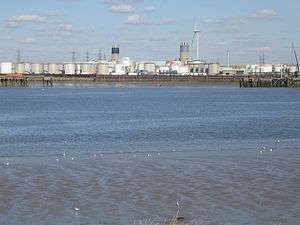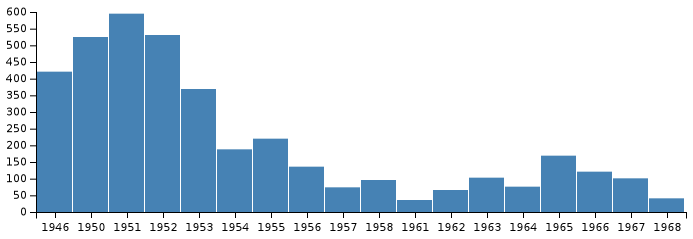Barking Power Station
Barking Power Station refers to a series of power stations at various sites within the London Borough of Barking and Dagenham in east London. The original power station site, of the coal-fired A, B and C stations, was at River Road, Creekmouth, on the north bank of the River Thames. These stations were decommissioned by 1981 and were subsequently demolished. The later gas-fired power station (originally generally known as Barking Reach Power Station) was built further down the Thames near Dagenham Dock in the early 1990s. The site of the former power stations is being redeveloped as Barking Riverside.
| Barking Power Station | |
|---|---|
 Barking Reach Power Station Viewed from the south in October 2007 | |

| |
| Country | England |
| Location | Greater London |
| Coordinates | 51.5210°N 0.1470°E |
| Status | Decommissioned and demolished |
| Construction began | 'A' 1925-28; 'B' 1931-39; 'C' 1952-54; Barking Reach 1992-95 |
| Commission date | 'A' 1925; 'B' 1933; 'C' 1954; Barking Reach 1995 |
| Decommission date | 'A' 1969; 'B' 1976; 'C' 1981; Barking Reach 2018 |
| Owner(s) | As operator |
| Operator(s) | Barking Town Urban District Council (1897-1927) County of London Electric Supply Company (1925-1948) British Electricity Authority (1948-1955) Central Electricity Authority (1955-1957) Central Electricity Generating Board (1957-1981) Thames Power Services (1995-present) |
| Thermal power station | |
| Primary fuel | Coal Oil Natural gas |
| Tertiary fuel | Coal |
| Chimneys | 'A' 10; 'B' 4; 'C' 2; Barking Reach 2 |
| Cooling towers | None |
| Cooling source | River water |
| Power generation | |
| Units operational | 'A' 3 × 40 MW & 1 × 36.75 MW; 'B' 4 × 75 MW; 'C' 3 × 77.5 MW; Barking Reach 1000 MW CCGT |
| Units decommissioned | All |
| Nameplate capacity | 220 MW & 144 MW |
| External links | |
| Commons | Related media on Commons |
grid reference TQ4893882469 | |
History
Barking A power station
Prior to the construction of Barking A Power Station, Barking Town Urban District Council operated its own small power station near its offices from 1897 until its closure in 1927.[1] In 1920, the County of London Electric Supply Company applied for permission to build a power station at Creekmouth in Barking capable of expansion to 600 MW.[2] The Barking A Station had 8 C. A. Parsons turbo-generators (4 × 40 MW and 4 × 20 MW) and 22 boilers, plus 2 dedicated reheat boilers. The two 40 MW sets were cross-compound units and one was the first Parsons set with reheat.[3] These were in two boiler houses, one being all chain grate boilers (6 Babcock & Wilcox and 6 Yarrow) and the other being all pulverised fuel boilers (I.C.L.). The maximum steam capacity of the A station boilers was 1,900,000 lb/hr (239 kg/s). Steam pressure and temperature at the turbine stop valves was 350 psi (24 bar) and 371°C.[4] Barking Power Station opened in 1925, and in 1927 it took over from the Barking Town Urban District Council station, providing a bulk electricity supply.[1] When completed, the A station was the largest power station in Britain to have been built as a complete station at one time. The Yarrow boilers were scrapped in the early 1950s, their capacity being replaced by steam from the B station via a steam line and suitable regulating equipment. The pulverised fuel boilers were converted to oil firing around 1964. By 1964 there were 3 × 40 MW and 1 × 36.75 MW generators.[4] One of the 40 MW machines was decommissioned in 1966. The A station was decommissioned in 1969.[4]
The site of the power station was chosen for easy delivery of coal from the Thames and by rail, as well as the abundant water supply and space on the site for expansion.[1] A cable tunnel was constructed under the river to supply the south bank with electricity.[5]
Barking B power station
Barking's original A station was extended by the building of the B station, which began to operate at full capacity in 1939. The capacity of the B Station was 303 MW with 4 × 75 MW B.T.H. turbo-generators plus a small house generator of 3.5 MW capacity. Steam conditions were 600 psig (41.4 bar) and 800 °F (427 °C). The B Station had 16 B&W chain grate boilers, each capable of producing 256,000 lbs steam per hour (32.3 kg/s). These were arranged in two boiler houses, with 8 boilers in each. The maximum total steam capacity of the B station boilers was 4,096,000 lb/hr (516 kg/s).[4] The power station was transferred to the London Division of the British Electricity Authority upon nationalisation of the electricity industry in 1948.[1] The B station closed on 15 March 1976, at which time its generating capacity was 144 megawatts.[6]
Barking C power station
The British Electricity Authority built a third station at Creekmouth, which was completed in 1954. The C Station had three B.T.H. 75 MW turbo-generators operating with steam conditions of 900 psig (62 bar) and 900 °F (482 °C). There were 6 B&W boilers, 5 being pulverised fuel and the sixth a cyclone furnace. The maximum steam capacity of the station boilers was 2,565,000 lb/hr (323 kg/s).[4] The pulverised fuel boilers were converted to oil firing around 1960. The station was closed on 26 October 1981, at which time its generating capacity was 220 MW.[6] All three stations have since been demolished.
Barking Reach power station
The last station was at Chequers Lane in Dagenham, to the west of Dagenham Breach (pond) and the Ford motor works. The station was constructed between 1992 and 1995 and was the first major generating station to be built in London for many years. It was one of the largest independently owned generating plants in the UK, being capable of generating 1000 MW of electricity, which is about 2% of the peak electricity demand in England and Wales.
The station used Combined Cycle Gas Turbine technology, with gas as its primary fuel. The station was owned by Barking Power Limited but was operated and managed by Thames Power Services.[12]
In July 2014 the operators announced their intention to close the power station within two years.[13] Decommissioning of the power station started in 2018, the chimneys being demolished using explosives.[14]
On 18 December 2018, it was reported [15] that the City of London had acquired Barking Power Ltd along with the Barking Reach Power Station site. The 42 acre site is one of the potential options for the City Corporation’s proposals to consolidate its three wholesale food markets; Billingsgate (fish), Smithfield (meat and poultry) and New Spitalfields (fruit, vegetables and flowers), onto a single site.
References
- "'The borough of Barking'". A History of the County of Essex: Volume 5 (1966), pp. 235-248. Victoria County History. Retrieved 5 December 2007.
- Mr. Holmes (4 November 1920). "ELECTRIC POWER SCHEMES, LONDON". Hansard. Retrieved 3 September 2009.
- The Electricity Council (1987). Electricity Supply in the United Kingdom: a Chronology. London: The Electricity Council. p. 44. ISBN 085188105X.
- CEGB Statistical Yearbook (various years). CEGB, London.
- Smith, D (2001). Civil Engineering Heritage: London and the Thames Valley. Thomas Telford. ISBN 0-7277-2876-8.
- Mr. Redmond (16 January 1984). "Coal-fired Power Stations". Hansard. Retrieved 1 September 2009.
- Garcke (1954). Garcke's Manual of Electricity Supply 1953. Garcke. pp. A-128.
- "British Power Stations operating at 31 December 1961". Electrical Review. 1 June 1962: 931.
- Garrett, Frederick C. (ed) (1959). Garke's Manual of Electricity Supply. London: Electrical Press. pp. A-112.CS1 maint: extra text: authors list (link)
- GEGB Annual report and accounts, various years
- Electricity Commission, Generation of Electricity in Great Britain year ended 31st December 1946. London: HMSO, 1947.
- "Barking Power Station". Barking Power. Retrieved 8 March 2008.
- "Barking Power Station in east London to close within two years". Reuters. 29 July 2014.
- "Barking Power Station chimneys blown down". The Construction Index. 15 March 2018.
- "City Corporation acquires Barking Reach Power Station site". City of London. 18 December 2018.
| Wikimedia Commons has media related to Barking Power Station. |
| Preceded by Carville B Power Station |
Largest Power Station in the UK 1925 |
Succeeded by Agecroft Power Station |
| Preceded by Fulham Power Station |
Largest Power Station in the UK 1954-1962 |
Succeeded by Drakelow Power Station |



